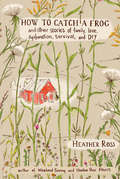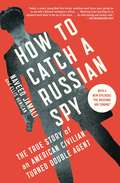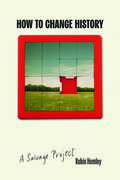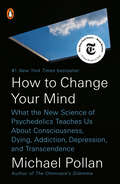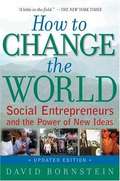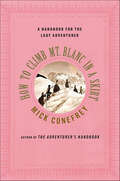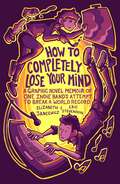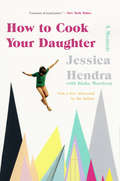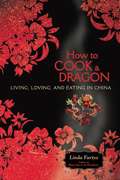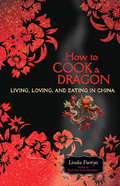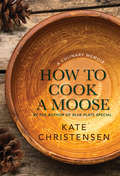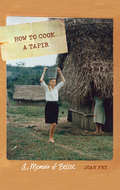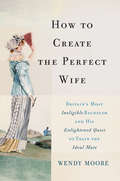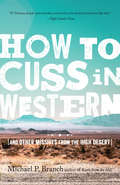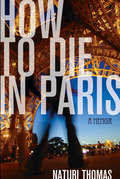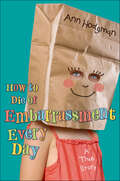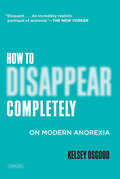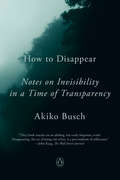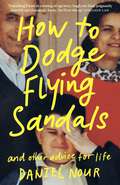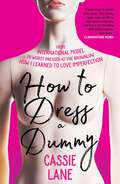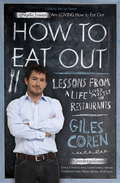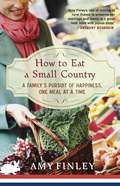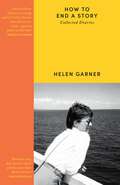- Table View
- List View
How to Catch a Frog: And Other Stories of Family, Love, Dysfunction, Survival, and DIY
by Heather RossStories about growing up in a family of artists and idealists in Vermont, complete with illustrations and how-to instructions. Much of author and illustrator Heather Ross’s work has been inspired by her childhood spent in a rural corner of Vermont during the 1970s. Her upbringing was defined by stunning natural beauty, innovative living, and daily lessons in self-reliance—but also dysfunction, a self-imposed but nearly inescapable poverty, and little exposure to basic life skills. When, in her twenties, Ross complained to her mother about a long list of things she had missed out on and that had compromised her chance of ever leading a “normal” life, her mother waved a hand and replied, “Well, you should thank me, because you have a lot of good stories instead.” How to Catch a Frog is a collection of those stories, plus others that show Ross’s eventual route to success as an artist, entrepreneur, and mother. “A very honest coming-of-age tale . . . The book reminded me of the powerful memoir Wild by Cheryl Strayed, and if you loved that book, this one will rock your world as well.” —Meg Cox, quilt journalist, author, and instructor
How to Catch a Russian Spy
by Ellis Henican Naveed JamaliThe fascinating story of a young American amateur who helped the FBI bust a Russian spy in New York--sold in ten countries and in a major deal to 20th Century Fox.For three nerve-wracking years, Naveed Jamali spied on America for the Russians, trading thumb drives of sensitive technical data for envelopes of cash, selling out his own beloved country across noisy restaurant tables and in quiet parking lots. Or so the Russians believed. In fact, this young American civilian was a covert double agent working with the FBI. The Cold War wasn't really over. It had just gone high-tech. How to Catch a Russian Spy is the one-of-a-kind story of how one young man's post-college adventure became a real-life US counter-intelligence coup. He had no previous counter-espionage experience. Everything he knew about undercover work, he'd learned from Miami Vice and Magnum P.I. reruns and movies like Ronin, Spy Game, and anything with Bond or Bourne in the title. And yet, hoping to gain experience to become a Navy intelligence officer, he convinced the FBI and the Russians they could trust him. With charm, cunning, and a big load of naiveté, he matched wits with a veteran Russian military-intelligence officer who was recruiting spies on American soil, out-maneuvering the Russian spy and his secret-hungry superiors. Along the way, Jamali and his FBI handlers cast a rare light on espionage activities at the Russian Mission to the United Nations in New York and earned a solid US win in the escalating hostilities between Moscow and Washington. Now, Jamali reveals the whole engaging story behind his double-agent adventure--from coded signals on Craigslist to the Russian spy's propensity for Hooters' Buffalo wings. Cinematic, news-breaking, and wildly entertaining, How to Catch a Russian Spy is an armchair spy fantasy brought to life. Film rights sold to 20th Century Fox for director Marc Webb (The Amazing Spider-Man, 500 Days of Summer).
How to Change History: A Salvage Project
by Robin HemleyIn How to Change History Robin Hemley grapples with the individual&’s navigation of history and the conflict between personal and public histories. In an attempt to restore, resurrect, and reclaim what might otherwise be lost, Hemley meditates and speculates on photography, scrapbooks, historical markers, travelogues, TV shows, real estate come-ons, washed up rock stars, incontinent dachshunds, stalkers, skeletons in the closet, and literature. He also examines his parents&’ lives as writers, documenting their under-seen influence on the art movements of the day. In one essay, he writes about his mother&’s first cousin, Roy, a survivor of Pearl Harbor whose troubled daughter murdered him. The essay &“Jim&’s Corner&” examines the notion of memorial plaques and how they often highlight erasure rather than forestall it. Hemley writes about a stranger whose World War II experiences were chronicled in a scrapbook Hemley bought at an estate sale. In this book about reconstruction, Hemley posits that while we cannot change events once they have passed, we can return to those events to learn and sometimes perhaps change our understanding of them.
How to Change Your Mind: What the New Science of Psychedelics Teaches Us About Consciousness, Dying, Addiction, Depression, and Transcendence
by Michael PollanNew York Times Book Review 10 Best Books of 2018A New York Times Notable Book The #1 New York Times bestseller.A brilliant and brave investigation into the medical and scientific revolution taking place around psychedelic drugs--and the spellbinding story of his own life-changing psychedelic experiences When Michael Pollan set out to research how LSD and psilocybin (the active ingredient in magic mushrooms) are being used to provide relief to people suffering from difficult-to-treat conditions such as depression, addiction and anxiety, he did not intend to write what is undoubtedly his most personal book. But upon discovering how these remarkable substances are improving the lives not only of the mentally ill but also of healthy people coming to grips with the challenges of everyday life, he decided to explore the landscape of the mind in the first person as well as the third. Thus began a singular adventure into various altered states of consciousness, along with a dive deep into both the latest brain science and the thriving underground community of psychedelic therapists. Pollan sifts the historical record to separate the truth about these mysterious drugs from the myths that have surrounded them since the 1960s, when a handful of psychedelic evangelists inadvertently catalyzed a powerful backlash against what was then a promising field of research.A unique and elegant blend of science, memoir, travel writing, history, and medicine, How to Change Your Mind is a triumph of participatory journalism. By turns dazzling and edifying, it is the gripping account of a journey to an exciting and unexpected new frontier in our understanding of the mind, the self, and our place in the world. The true subject of Pollan's "mental travelogue" is not just psychedelic drugs but also the eternal puzzle of human consciousness and how, in a world that offers us both suffering and joy, we can do our best to be fully present and find meaning in our lives.
How to Change the World: Social Entrepreneurs and the Power of New Ideas
by David BornsteinNow published in more than twenty countries, David Bornstein's How to Change the World has become the bible for social entrepreneurship--in which men and women around the world are finding innovative solutions to a wide variety of social and economic problems. Whether delivering solar energy to Brazilian villagers, expanding work opportunities for disabled people across India, creating a network of home-care agencies to serve poor people with AIDS in South Africa, or bridging the college-access gap in the United States, social entrepreneurs are pioneering problem-solving models that will reshape the 21st century. How to Change the World provides vivid profiles of many such individuals and what they have in common. The book is an In Search of Excellence for social initiatives, intertwining personal stories, anecdotes, and analysis. Readers will discover how one person can make an astonishing difference in the world. The case studies in the book include Jody Williams, who won the Nobel Peace Prize for the international campaign against landmines she ran by e-mail from her Vermont home; Roberto Baggio, a 31-year old Brazilian who has established eighty computer schools in the slums of Brazil; and Diana Propper, who has used investment banking techniques to make American corporations responsive to environmental dangers. The paperback edition will offer a new foreword by the author that shows how the concept of social entrepreneurship has expanded and unfolded over the last few years, including the Gates-Buffett's charitable partnership, the rise of Google, and the increased mainstream coverage of the subject. The book will also update the stories of individual social entrepreneurs that appeared in the cloth edition.
How to Climb Mt. Blanc in a Skirt: A Handbook for the Lady Adventurer
by Mick Conefrey• Which explorer found the lost site of Jesus' first miracle?• Who was first to the top of the highest mountain in Peru?• Who was the first Westerner to visit the Ottoman harem in Constantinople?• Who held the world record as the only person to fly from Britain to Australia for 44 years? You'll find the answers to these questions and more in Mick Conefrey's charming new book (a hint: none of them had beards). In 1870, New York mountaineer Meta Brevoort climbed Mt. Blanc in a hoop skirt. Pausing at the summit only long enough to drink a glass of champagne and dance the quadrille with her alpine guides, she marched back down the mountain and into history as one of the first female mountain explorers. Here, Mick Conefrey weaves together tips, how-tos, anecdotes, and eccentric lists to tell the amazing stories of history's great female explorers—women who were just as fascinating and inspiring as all the Shackletons, Mallorys, and Livingstones. Most were brave, some were reckless, and all were fascinating. From Fanny Bullock Workman, who was photographed on top of a mountain pass in the Karakoram, holding up a banner calling for "Votes for Women" to Mary Hall, the Victorian world traveler, whose motto was, "take every precaution and abandon all fear," How to Climb Mt. Blanc in a Skirt is uproariously funny and occasionally downright strange.
How to Completely Lose Your Mind: A Graphic Novel Memoir of One Indie Band's Attempt to Break a World Record
by Eric Stevenson Elizabeth JancewiczAn Indie Band’s Record-Breaking Music Tour: A Graphic Novel“As a touring musician, I absolutely adored this heartfelt, honest, and beautifully illustrated account of the unique pitfalls and victories of DIY touring.” ―Tommy Siegel, cartoonist and guitarist/singer in Jukebox the Ghost#1 New Release in Biographies and History Graphic NovelsFrom the indie band Pocket Vinyl and the artists behind the documentary Drive. Play. Sleep. and the popular webcomic The Touring Test, this hilarious artists’ graphic novel memoir chronicles a couple’s road trip across the USA as they break a world record.A world record smashing music tour through 50 States in 45 Days. Together, Eric Stevenson and Elizabeth Jancewicz perform as the band Pocket Vinyl, where Eric slams on the piano and sings while Elizabeth creates a large oil painting on stage. In these artists’ graphic novel, watch as they take on their biggest challenge yet: to tour the whole nation in just 45 days, breaking the record for the fastest time a band has played in all 50 U.S. states.A wild road trip of performance highs, self-doubt lows, and determination. As co-author Elizabeth Janceqicz says, “I knew that embarking on such a monstrous adventure would provide me with stories to tell, but I hadn't realized how much those stories would change me... In retrospect, we learned so much: about how our art helps people, how interconnected we all are, and how easily our minds can descend into mental illness without us even realizing it’s happening.”Inside find:A breakneck road trip through the local music scenes across America An unforgettable story of what life is like behind the scenes on an indie band’s record-breaking tourA graphic novel on mental health, humor, the love of music and art, and the gifts of human kindnessIf you liked It's Lonely at the Centre of the Earth, Marbles, or Can't We Talk about Something More Pleasant? you'll love How to Completely Lose Your Mind.
How to Cook Your Daughter: A Memoir
by Jessica HendraFrom the daughter of the bestselling author of Father Joe: the poignant and ultimately hopeful memoir of a young girl’s struggle to live a normal childhood in the chaotic seventies, and to overcome sexual abuse by her famous fatherEarlier this year, Tony Hendra’s memoir, Father Joe: The Man Who Saved My Soul, spent thirteen weeks on the New York Times bestseller list. The book detailed his life as a comedian who launched the careers of John Belushi and Chevy Chase and helped create such cult classics as This Is Spinal Tap, while he struggled with inner demons including alcohol and drug abuse. But there was a glaring omission in his supposed tell-all confessional: his sexual abuse of his daughter, Jessica Hendra, when she was a young girl. After more than thirty years of silence, Hendra has decided to reveal the truth. In this poignant memoir, she reveals the full story behind the New York Times article that rocked the world and detailed her father’s crimes. But Jessica’s story is no footnote to her father’s story. No One Was Listening is also the inspiring story of her own journey, and how she was finally able to find healing within, after years of struggling with anorexia, bulimia, and low self-esteem. Set against the backdrop of the chaotic seventies, Hendra’s memoir follows Jessica and her sister Kathy as they strove to make a normal life for themselves amidst the madness, sex, and drug abuse that her parents and their friends—many of the household names in the world of show business—participated in. No One Was Listening reveals the hope and heartache of a young girl who was faced with a loss of innocence at an early age, who faced a slow and painful recovery, and who finally found contentment and peace within.
How to Cook a Dragon
by Linda FuriyaWhen Linda Furiya decided to move to China with her boyfriend at the age of thirty, she hoped to find romance and ethnic kinship. Expecting common ground with locals as an Asian American, Furiya struggled with her ambition as a food writer in a nation where notions of race and gender are set in stone. During the six years she lived in Beijing and Shanghai, Furiya experienced a wide range of experiences--loneliness, isolation, friendship, and love--tied together by one common theme: food. Ultimately, Furiya surpassed these challenges and found inspiration from the courageous Chinese women who graced her life. The sensuous experience of preparing and eating authentic Chinese cuisine follows Furiya throughout her journey, and ultimately reveals the intimate, nurturing side of the Chinese culture and people. Part insightful memoir, part authentic cookbook, How to Cook a Dragon is a revealing look at race, love, and food in China.
How to Cook a Dragon: Living, Loving, and Eating in China
by Linda FuriyaWhen Linda Furiya decided to move to China with her boyfriend at the age of thirty, she hoped to find romance and ethnic kinship. Expecting common ground with locals as an Asian American, Furiya struggled with her ambition as a food writer in a nation where notions of race and gender are set in stone. During the six years she lived in Beijing and Shanghai, Furiya experienced a wide range of experiences-loneliness, isolation, friendship, and love-tied together by one common theme: food.Ultimately, Furiya surpassed these challenges and found inspiration from the courageous Chinese women who graced her life. The sensuous experience of preparing and eating authentic Chinese cuisine follows Furiya throughout her journey, and ultimately reveals the intimate, nurturing side of the Chinese culture and people. Part insightful memoir, part authentic cookbook, How to Cook a Dragon is a revealing look at race, love, and food in China.
How to Cook a Moose: A Culinary Memoir
by Kate ChristensenInspired by her move from Brooklyn to Maine and New Hampshire, as well as the slow-food, buy local movement that has re-energized sustainable farming, bestselling author Kate Christensen turns her blockbuster talent to telling the story of the hardship and happiness that has sustained her adopted home through thick and thin, as demonstrated through the staple foods of the region. Using her candid blend of humor, insight, culinary knowledge, and taste for rugged adventure, Christensen takes the reader on a journey into the lives and landscapes of the farmers, fishermen, hunters, and families that are trying to make do with what they have and still produce delicious, healthful food. She also details the history of food in the region and the secrets to cultivating her own sources of joy. A mouthwatering stew that combines the magic ingredients of love, personal appetites, hard labor, history, and original recipes based on foods featured in the book.
How to Cook a Tapir: A Memoir of Belize (At Table)
by Joan FryIn 1962 Joan Fry was a college sophomore recently married to a dashing anthropologist. Naively consenting to a year-long “working honeymoon” in British Honduras (now Belize), she soon found herself living in a remote Kekchi village deep in the rainforest. Because Fry had no cooking or housekeeping experience, the romance of living in a hut and learning to cook on a makeshift stove quickly faded. Guided by the village women and their children, this twenty-year-old American who had never made more than instant coffee came eventually to love the people and the food that at first had seemed so foreign. While her husband conducted his clinical study of the native population, Fry entered their world through friendships forged over an open fire. Coming of age in the jungle among the Kekchi and Mopan Maya, Fry learned to teach, to barter and negotiate, to hold her ground, and to share her space—and, perhaps most important, she learned to cook.This is the funny, heartfelt, and provocative story of how Fry painstakingly baked and boiled her way up the food chain, from instant oatmeal and flour tortillas to bush-green soup, agouti (a big rodent), gibnut (a bigger rodent), and, finally, something even the locals wouldn’t tackle: a “mountain cow,” or tapir. Fry’s efforts to win over her neighbors and hair-pulling students offers a rare and insightful picture of the Kekchi Maya of Belize, even as this unique culture was disappearing before her eyes.
How to Create the Perfect Wife: Britain's Most Ineligible Bachelor and his Enlightened Quest to Train the Ideal Mate
by Wendy MooreThomas Day, an 18th-century British writer and radical, knew exactly the sort of woman he wanted to marry. Pure and virginal like an English country maid yet tough and hardy like a Spartan heroine, she would live with him in an isolated cottage, completely subservient to his whims. But after being rejected by a number of spirited young women, Day concluded that the perfect partner he envisioned simply did not exist in frivolous, fashion-obsessed Georgian society. Rather than conceding defeat and giving up his search for the woman of his dreams, however, Day set out to create her. So begins the extraordinary true story at the heart of How to Create the Perfect Wife, prize-winning historian Wendy Moore's captivating tale of one man's mission to groom his ideal mate. A few days after he turned twenty-one and inherited a large fortune, Day adopted two young orphans from the Foundling Hospital and, guided by the writings of Jean-Jacques Rousseau and the principles of the Enlightenment, attempted to teach them to be model wives. After six months he discarded one girl, calling her "invincibly stupid," and focused his efforts on his remaining charge. He subjected her to a number of cruel trials--including dropping hot wax on her arms and firing pistols at her skirts--to test her resolve but the young woman, perhaps unsurprisingly, eventually rebelled against her domestic slavery. Day had hoped eventually to marry her, but his peculiar experiment inevitably backfired--though not before he had taken his theories about marriage, education, and femininity to shocking extremes. Stranger than fiction, blending tragedy and farce, How to Create the Perfect Wife is an engrossing tale of the radicalism--and deep contradictions--at the heart of the Enlightenment.
How to Cuss in Western: And Other Missives from the High Desert
by Michael P. BranchWhere nature writing meets humor--a racuous and hilarious look at life in the high desert of Nevada, from the author of Raising Wild and Rants from the Hill.Edward Abbey encouraged his readers to “be loyal to what you love, be true to the Earth, and fight your enemies with passion and laughter.” Here is Michael Branch’s response. Full of clear-eyed explorations of the natural world, witty cultural observations, and heart-warming family connections, How to Cuss in Western is a cranky and hilarious love letter of sorts to the western Great Basin Desert of Nevada.
How to Die in Paris: A Memoir
by Naturi ThomasHow to Die in Parisis an edgy, poetic, often darkly comic, memoir of a young middle-class black woman who escapes a tortured past in New York to pursue a new life in Europe-only to find herself broke, desperate, and contemplating suicide on the streets of Paris. Penniless, scared, and hoping for rescue, Thomas turns to a series of unlikely male suitors: an impoverished Italian who exposes her to the reality of immigrant struggle, a fast-talking squatter who lures her into Paris’s street youth culture, and a beautiful Tunisian who takes her home . . . only to introduce her to a world of pain. Each encounter awakens in her memories from her childhood-memories of the abuse and racism she experienced at the hands of her mother-and forces her to confront the darkness in her past, even as she struggles to survive in the present. Though the trials she faces in Paris are often harrowing, Thomas is anything but self-pitying, often culling humor from gritty moments, and she finds goodness in the small blessings that come her way: a library that offers warmth and escape, a sandwich abandoned in a phone booth, the generosity of strangers, and especially, the wonder of Paris itself. Ultimately, being homeless in the City of Light frees her of the denial and defenses that have been holding her back all her life-revealing a broader world too beautiful to leave.
How to Die of Embarrassment Every Day: A True Story
by Ann HodgmanHumorous and humiliating memories of an awkward childhood, sprinkled with hilarious family photographs and other memorabilia, from the author of The House of a Million Pets. Ann Hodgman is a funny lady. In How to Die of Embarrassment Every Day, she explains how she got that way. But the book only goes up through sixth grade. After that, her life became so embarrassing that writing it down would have caused the pages to burst into flames.
How to Disappear Completely: On Modern Anorexia
by Kelsey OsgoodAt fourteen, Kelsey Osgood became fascinated by the stories of women who starved themselves. She devoured their memoirs and magazine articles, committing the most salacious details to memory to learn what it would take to be the very best anorexic. When she was hospitalized at fifteen, she found herself in an existential wormhole: how can one suffer from something one has actively sought out? With attuned storytelling and unflinching introspection, Kelsey Osgood unpacks the modern myths of anorexia as she chronicles her own rehabilitation. How to Disappear Completely is a brave, candid and emotionally wrenching memoir that explores the physical, internal, and social ramifications of eating disorders.
How to Disappear: Notes on Invisibility in a Time of Transparency
by Akiko BuschVivid, surprising, and utterly timely, Akiko Busch's HOW TO DISAPPEAR explores the idea of invisibility in nature, art, and science, in search of a more joyful and peaceful way of living in today's increasingly surveilled and publicity-obsessed worldIn our increasingly networked and image-saturated lives, the notion of disappearing has never been both more enchanting and yet fanciful. Today, we are relentlessly encouraged, even conditioned, to reveal, share, and self-promote. The pressure to be public comes not just from our peers, but vast and pervasive technology companies, which want to profit from patterns in our behavior. A lifelong student and observer of the natural world, Busch sets out to explore her own uneasiness with this arrangement, and what she senses is a widespread desire for a less scrutinized way of life--for invisibility. Writing in rich painterly detail about her own life, her family, and some of the world's most exotic and remote places--from the Cayman Islands to Iceland--she savors the pleasures of being unseen. Discovering and dramatizing a wonderful range of ways of disappearing, from virtual reality goggles that trick the wearer into believing her body has disappeared and to the way Virginia Woolf's fictional Mrs. Dalloway feels a flickering of personhood as an older woman, Busch deliberates on subjects new and old with equal sensitivity and incisiveness.A unique and exhilarating accomplishment, HOW TO DISAPPEAR is a shimmering collage of poetry, cinema, memoir, myth, and much more, which overturns the dangerous modern assumption that somehow fame and visibility equate to success and happiness. Busch presents a field guide to invisibility, reacquainting us with the merits of the inconspicuousness, and finds genuine alternatives to the typical life of perpetual exposure. Accessing timeless truths in order to speak to our most urgent contemporary problems, she inspires us to develop a deeper appreciation for personal privacy in a vast and invasive world.
How to Dodge Flying Sandals and Other Advice for Life: An unreliable ethnic memoir
by Daniel NourIf you've ever had someone try to arrange a marriage for you …If you have so many cousins you can't remember all their names …If your parents only show love through food and unsolicited advice …If your family still thinks your 'roommate' is 'just a great friend' …Then this book is for you. And if you've never experienced any of this? Well, aren't you just a little curious? Meet Daniel Nour: Egyptian and Australian; loud and painfully awkward; conservative and very confused (especially about other boys). He's never quite pulled off normal, but 'not-normal' is where the best stories are. Now he's made his peace with that and is ready to share his wisdom in this highly unreliable ethnic memoir. Told as a series of snapshots from Daniel's life – from 'How to Be Born' to 'How to Die' and everything in between – this is a sharply funny tale of culture, family and trying, but not always managing, to come of age. At turns wildly absurd, sharply insightful and disarmingly heartfelt, How to Dodge Flying Sandals and Other Advice for Life is a fresh take on growing up in Australia.
How to Dress a Dummy
by Cassie LaneFor as long as she could remember, Cassie Lane yearned to be somebody else. Not only was she socially awkward, she was odd-looking and her dysfunctional family were the type of people who bonded over stealing their Christmas tree every year. Miraculously, at sixteen, Cassie?s prayers were answered and she got boobs ? big ones! Suddenly the centre of attention, she went from gawky bogan to international model, strutting catwalks from Milan to LA. But beneath the gloss she discovered a world of exploitation, where living off your looks can attract as much scorn as admiration. Her search for a version of herself she could actually like took her from Hollywood parties, to an island ashram, and reluctantly back into the spotlight as an AFL `WAG?, a position where one wrong step can get you labelled a `slut?, `skank? and `stripper?. In time the gawky bogan came full circle, and Cassie grew to understand that beauty is not about high cheekbones or a 24-inch waist. True beauty is found in the imperfect and vulnerable. How to Dress a Dummy casts an unwavering eye at the myriad ways in which women are taught that they?re not enough. Smart, frank and very, very funny, Cassie?s is a bold new feminist voice.
How to Dress a Dummy
by Cassie LaneFor as long as she could remember, Cassie Lane yearned to be somebody else. Not only was she socially awkward, she was odd-looking and her dysfunctional family were the type of people who bonded over stealing their Christmas tree every year.Miraculously, at sixteen, Cassie's prayers were answered and she got boobs - big ones! Suddenly the centre of attention, she went from gawky bogan to international model, strutting catwalks from Milan to LA. But beneath the gloss she discovered a world of exploitation, where living off your looks can attract as much scorn as admiration. Her search for a version of herself she could actually like took her from Hollywood parties, to an island ashram, and reluctantly back into the spotlight as an AFL 'WAG', a position where one wrong step can get you labelled a 'slut', 'skank' and 'stripper'. In time the gawky bogan came full circle, and Cassie grew to understand that beauty is not about high cheekbones or a 24-inch waist. True beauty is found in the imperfect and vulnerable.How to Dress a Dummy casts an unwavering eye at the myriad ways in which women are taught that they're not enough. Smart, frank and very, very funny, Cassie's is a bold new feminist voice.
How to Eat Out
by Giles CorenIt has taken Giles Coren a lifetime to master the art of eating out.From a lonely childhood spent in restaurant car parks, peering in at a magical world of chickens in baskets and butter in little foil squares, to belching his way through fifty pointless manifestations of nitrogen-chilled excreta at 'the best restaurant in the world', to the sticky corner of Bangkok's Chinatown where he sat his own baby daughter down in front of her first jellied iguana foot and was genuinely surprised when she didn't like it, Coren has experienced pretty much everything a restaurant can throw at you, and thrown it right back. Or at least caught it, sniffed it, and bagged it up for later.Bad waiters, bum tables, little rip-offs, big cons, old fish, cheap meat, yesterday's soup and tomorrow's gastroenteritis... Coren tells you how to avoid the lot, and even come out of it with free champagne and a dish named after you by way of apology.It doesn't matter if it's fish and chips, takeaway pizza, a medieval banquet with Sue Perkins or a slap-up nosh at the Hotel de Posh, there is always a right way and wrong way to do it. How to Eat Out is a bit of both.
How to Eat Out
by Giles CorenIt has taken Giles Coren a lifetime to master the art of eating out.From a lonely childhood spent in restaurant car parks, peering in at a magical world of chickens in baskets and butter in little foil squares, to belching his way through fifty pointless manifestations of nitrogen-chilled excreta at 'the best restaurant in the world', to the sticky corner of Bangkok's Chinatown where he sat his own baby daughter down in front of her first jellied iguana foot and was genuinely surprised when she didn't like it, Coren has experienced pretty much everything a restaurant can throw at you, and thrown it right back. Or at least caught it, sniffed it, and bagged it up for later.Bad waiters, bum tables, little rip-offs, big cons, old fish, cheap meat, yesterday's soup and tomorrow's gastroenteritis... Coren tells you how to avoid the lot, and even come out of it with free champagne and a dish named after you by way of apology.It doesn't matter if it's fish and chips, takeaway pizza, a medieval banquet with Sue Perkins or a slap-up nosh at the Hotel de Posh, there is always a right way and wrong way to do it. How to Eat Out is a bit of both.
How to Eat a Small Country: A Family's Pursuit of Happiness, One Meal at a Time
by Amy Finley“How to Eat a Small Country’’ shares a few key traits with Elizabeth Gilbert’s “Eat, Pray, Love,’’ in particular an infectiously likeable narrator and mouthwatering descriptions of European food. But Finley’s memoir is less precious, more honest, and ultimately more rewarding. " -- Boston Globe A professionally trained cook turned stay-at-home mom, Amy Finley decided on a whim to send in an audition tape for season three of The Next Food Network Star, and the impossible happened: she won. So why did she walk away from it all? A triumphant and endearing tale of family, food, and France, Amy’s story is an inspiring read for women everywhere. While Amy was hoping to bring American families together with her simple Gourmet Next Door recipes, she ended up separating from her French husband, Greg, who didn’t want to be married to a celebrity. Amy felt betrayed. She was living a dream-or was she? She was becoming famous, cooking for people out there in TV land, in thirty minutes, on a kitchen set . . . instead of cooking and eating with her own family at home. In a desperate effort to work things out, Amy makes the controversial decision to leave her budding television career behind and move her family to France, where she and Greg lived after they first met and fell in love. How to Eat a Small Country is Amy’s personal story of her rewarding struggle to reunite through the simple, everyday act of cooking and eating together. Meals play a central role in Amy’s new life, from meeting the bunny destined to become their classic Burgundian dinner of lapin la moutarde to dealing with the aftermath of a bouillabaisse binge. And as she, Greg, and their two young children wend their way through rural France, they gradually reweave the fabric of their family. At times humorous and heart-wrenching, and always captivating and delicious, How to Eat a Small Country chronicles the food-filled journey that one couple takes to stay together.
How to End a Story: Collected Diaries
by Helen Garner'I revere Helen Garner's writing, and it's in her diaries that she's at her acute, rigorous, pitch-perfect best'Nigella Lawson'I come back again and again to Garner's diaries and always find something new to admire. Her wit and observations are brilliant and her thoughts on writing are a guide'Daisy Johnson'I love Helen Garner's diaries. I would read her grocery lists'Fatima Bhutto'The diaries are the apotheosis of Helen Garner's entire career, and the most exciting thing she has ever published . . . Beautiful, riveting, formally electrifying'Lit HubLooking out the window at the two big gum trees, as it gets dark, I think: the only way I can go on keeping a diary - the bits about myself, anyway, i.e. most of it - is to conceive of it as a record of soul.Helen Garner has kept a diary for most of her adult life. Now she is widely recognised as one of the greatest writers of our age. But, of all her books, it is her diaries that she likes best.Collected for the first time into one volume, these inimitable diaries show Garner like never before: as a fledging author in bohemian Melbourne, publishing her lightning-rod debut novel while raising a young daughter in the 1970s; in the throes of an all-consuming love affair in the 1980s; and clinging to a disintegrating marriage in the 1990s.How to End a Story reveals the inner life of a woman in love, a mother, a friend and a formidable writer at work. Told with devastating honesty, steel-sharp wit and an ecstatic attention to the details of everyday life, it offers all the satisfactions of a novel alongside the enthralling intimacy of something written in private and just for pleasure.
